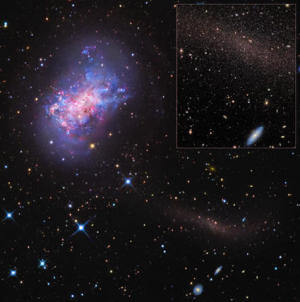The Subaru Space Telescope was able to notice individual stars merging into the dwarf galaxy NGC 4449, which is 12.5 million light-years away from us, and this is how they noticed that this dwarf galaxy is also swallowing a smaller galaxy.

A new image of a nearby dwarf galaxy has revealed a dense stream of stars in its outer regions, remnants of an even smaller companion galaxy in the process of merging with its host galaxy.
The host galaxy, known as NGC 4449, is the smallest main galaxy in which stellar streams from a recently completed merger have been detected and studied in detail.
"This is the way in which galaxies grow. You see that small galaxies come closer and are torn to pieces and finally leave their stars scattered in the outer halo of the host galaxy" says Aron Romanovsky, an astronomer at the University of California, Santa Cruz. and the author of the article about the discovery that was accepted for publication in the Astrophysical Journal Letters. The research was carried out by a team of astronomers led by David Martinez-Delgado from the Max Planck Institute for Astronomy in Heidelberg, Germany.
According to modern cosmological theory, large galaxies are built from smaller galaxies swallowed up during the history of mergers. Astronomers can see many examples of mergers involving giant galaxies engulfing smaller galaxies, but a merger of two dwarf galaxies has been difficult to detect. "We should have seen the same phenomenon also on a small scale when small galaxies swallow even smaller galaxies and so on" said Romanovsky. "Now we have the beautiful image of a dwarf galaxy eating a smaller galaxy."
NGC 4449 is located 12.5 million light years from Earth and is a member of a group of galaxies in the constellation Canes Venatici. In size and configuration it is very similar to one of the satellite galaxies of the Milky Way - the Large Magellanic Cloud.
The stream of stars in NGC 4449 was first discovered by another group of astronomers as a faint spot in the Skyscanning Project and is also visible in the image archive of the Sloan Digital Sky Scanner. If it were a little paler, more diffuse and far from its host galaxy it could easily be missed. The researchers called the process a "stealth merger", because this galaxy is outside the detection capability of conventional equipment, but it still affects the host galaxy (the largest in the group).
Using the half-meter telescope at the Black Bird Observatory in the Sierra Nevada Mountains, Martinez took wide-angle images of NGC 4449. These images confirm the presence of faint structure in this galaxy's halo. Romanowski, along with UCSC doctoral student Jacob Arnold, used the 8.2-meter Subaru Telescope in Hawaii to obtain a high-resolution image of individual stars in the galactic stream.
"I don't think I've ever seen a picture of a star merger where you see individual stars," said Romanovsky. "This is a very impressive picture."
The new observations support the idea that the halos of stars surrounding dwarf Rabum galaxies are the remnants of smaller satellite galaxies that were torn apart in past merger events. The ongoing merger of NGC 4449 may also be responsible for the burst of star formation seen in the galaxy.
"This galaxy is famous for its abundance of star formation, and now we seem to have discovered why. The gravitational interaction of the incoming galaxy apparently dispersed the gas in the main galaxy and caused it to start forming stars." Romanovsky said.
The eaten galaxy was also discovered separately by a team of scientists led by Michael Rich from UCLA University, based on images obtained by the 28 inch telescope at the Polaris Observatory in California and will be published in the February 9 issue of the journal Nature.
